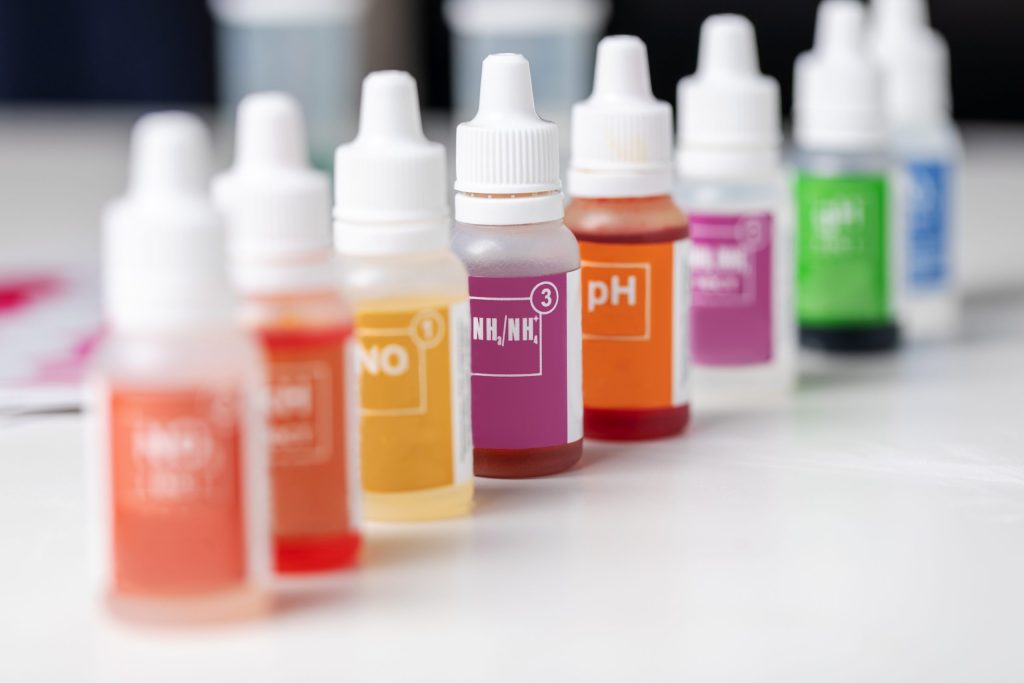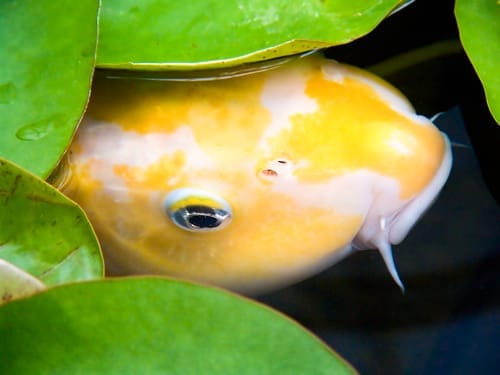
Mastering Ammonia and Nitrite Management in Koi Ponds: A Comprehensive Guide
Managing ammonia and nitrite levels in koi ponds is crucial for maintaining koi health. High levels can stress or kill fish, making regular monitoring essential. This comprehensive guide on ammonia and nitrite management in koi ponds explains the causes of ammonia and nitrite buildup, the impact on koi, and offers practical solutions for maintaining safe levels. Expect to learn effective filtration methods, natural management techniques, and seasonal considerations to ensure your pond thrives throughout the year.
Key Takeaways
Ammonia and nitrite management is crucial for koi health, as high levels can lead to stress, disease, or death.
Factors such as seasonal changes, water temperature, pH, and pond size significantly influence ammonia and nitrite levels.
Regular maintenance practices, including water testing, changes, and debris removal, are essential for maintaining optimal water quality in koi ponds.
Understanding Ammonia and Nitrite in Koi Ponds

In koi ponds, the nitrogen cycle encompasses vital elements like ammonia and nitrite. Ammonia originates from sources such as the waste of koi, unconsumed food, and decaying organic substances. Without proper control, its levels can become dangerous. The equilibrium of ammonia in the pond hinges on how efficiently it is produced against how effectively it’s eliminated. Since a single test only offers an instantaneous view of conditions within the pond, ongoing testing is imperative.
Beneficial bacteria are pivotal for transforming perilous ammonia into nitrite—a less harmful byproduct—through nitrification during this cycle. As part of sustaining optimal water quality in koi ponds, these bacteria play an indispensable role by converting noxious ammonia to relatively harmless nitrite and ultimately to harmless nitrate.
Ensuring superior water quality is instrumental for maintaining robust health among koi. Substandard conditions may cause stress or diseases that could be fatal to these fish. To shield your koi from harm and promote a thriving pond ecosystem requires diligent oversight over levels of both ammonia and nitrite through vigilant monitoring practices coupled with preventive management strategies.
Sources of Ammonia
In koi ponds, ammonia primarily originates from the excretion of the fish themselves, food that remains unconsumed and subsequently breaks down, as well as other decaying organic materials. Quantity and protein levels present in the feed play a crucial role in determining how much waste is produced by the fish. Uneaten food contributes to the accumulation of organic debris which decomposes and elevates ammonia concentrations.
The decomposition process of dead algae along with additional organic substances settled at the bottom of these ponds also adds to this increase in ammonia levels. By recognizing these contributing factors, pond caretakers can better manage and curtail the production of ammonia within their aquatic environments—ensuring they remain clean and safe for koi habitation.
Formation of Nitrite
Beneficial bacteria in the pond are instrumental for nitrification, which is the conversion of ammonia to nitrite. These microbes are vital to maintaining a healthy nitrogen cycle by transforming harmful ammonia first into less dangerous nitrite and subsequently into nitrate.
Several factors influence how well this process occurs, such as the concentration of ammonia, ambient temperature, and levels of dissolved oxygen. When conditions are ideal, these variables work together to facilitate successful nitrification that regulates both ammonia and nitrite concentrations.
Impact on Koi Health
Severe health issues in koi, such as lethargy and potentially progressing to coma or death, can be caused by high ammonia concentrations. Following an increase in ammonia levels, there is also a risk of elevated nitrite levels that may lead to oxygen deprivation for the fish.
Maintaining optimal water quality is essential in safeguarding koi from stress and diseases. Particularly during spring when feeding frequency increases, it’s crucial to vigilantly track ammonia concentrations to prevent toxic conditions.
Factors Influencing Ammonia and Nitrite Levels

Ammonia and nitrite levels, which affect the water quality of koi ponds, are influenced by various elements. These include seasonal variations, fluctuations in water temperature, pH balance, as well as the dimensions of the pond and its stocking density.
It is essential for those maintaining koi ponds to comprehend these variables to control ammonia and nitrite concentrations successfully. Acknowledging these factors enables keepers to ensure a consistently healthy habitat for their koi through vigilant management.
Water Temperature
The toxicity of ammonia in koi ponds is highly influenced by the water temperature. As it rises, so does the harmfulness of ammonia to koi. Beneficial bacteria that regulate levels of ammonia become less efficient under severe temperatures, especially when there’s a deficiency in oxygen.
By maintaining consistent water temperatures, you can diminish the toxic impact of ammonia and boost the functionality of these helpful microorganisms. A pond heater can aid in this stabilization or it could be accomplished by confirming sufficient movement and oxygenation within the pond’s water.
pH Levels
The pH level of the pond water also impacts ammonia toxicity. The optimal pH range for koi ponds is between 7.0 and 8.5. Higher pH levels shift ammonia to a more toxic form, increasing the risk to koi.
Effective ammonia management requires a stable pH. Bacteria that break down ammonia thrive in specific pH ranges, so adjusting pH levels can enhance their activity and improve water quality.
Pond Size and Stocking Density
The size of the pond and the number of koi it contains play vital roles in controlling ammonia levels. Ammonia is more efficiently diluted in larger ponds because there’s a greater volume of water to work with. On the other hand, smaller ponds that are densely stocked may experience rapid build-ups of ammonia.
Maintaining an optimal number of koi for your pond size contributes to maintaining equilibrium within its ecosystem and achieving excellent water quality. It’s important to continually check on and make necessary changes to how many fish you keep so as not to provoke surges in ammonia concentrations.
Effective Filtration Systems for Ammonia and Nitrite Control

Maintaining water quality and clarity in koi ponds necessitates a strong filtration system. To effectively remove various pollutants, an efficient filtration system integrates mechanical, biological, and chemical processes.
The implementation of these multi-stage systems facilitates comprehensive treatment of the pond’s water, fostering a secure and beneficial habitat for koi. Choosing the appropriate filtration system that matches pond traits along with consistent upkeep is crucial to ensure peak functionality.
Mechanical Filtration
Mechanical filtration serves to extract sizable particulates including debris, leaves, and fish waste from pond water. It plays a vital role by alleviating the pressure on biological and chemical filters, thus boosting the entire efficiency of the filtration system.
To guarantee optimal operation and efficient elimination of solid waste, mechanical filters need consistent maintenance. Such care is essential in preserving the clarity and quality of the water, which results in a more conducive habitat for koi.
Biological Filtration
Relying on beneficial bacteria, biological filtration converts harmful ammonia into less dangerous forms like nitrite and nitrate. It’s essential to have a biological filtration system that is appropriately sized in order to avoid surges in ammonia levels and keep the pond ecosystem stable.
The health of beneficial bacteria can be supported by regularly checking and upkeeping biological filters. This improves their ability to regulate the concentration of toxic ammonia efficiently.
Chemical Filtration
Utilizing substances like activated carbon, chemical filtration serves to extract harmful dissolved toxins from the water in a pond. This method is crucial for sustaining a conducive living space for koi, as it purges elements that may provoke stress and disease.
The deployment of proficient chemical filtration substantially improves the quality of the water, which is pivotal for maintaining the health and vitality of koi residing within the pond. To ensure its continued effectiveness, it’s important to consistently replace the media used in chemical filters.
Regular Maintenance Practices
Maintaining a thriving environment for koi requires vigilant upkeep to manage levels of ammonia and nitrite in their ponds. It is crucial to conduct frequent water changes, control feeding quantities, and clear out any debris to sustain the optimal water quality.
Implementing these tasks regularly as part of pond maintenance ensures that a secure and flourishing habitat is provided for the koi.
Routine Water Testing
Regularly checking water parameters is crucial to identify any potential imbalances that may pose a risk to koi health. It’s important to keep an eye on the levels of ammonia and nitrite, as their elevation can lead to serious health problems.
Ensuring that tests for ammonia, nitrite, nitrate, and pH are conducted routinely helps in maintaining a safe habitat for fish. This becomes particularly vital following periods of intense fish activity or significant rainfall events.
Water Changes
Regular water changes dilute harmful substances and maintain essential mineral levels in the pond. A partial water change of 10-25% every two to four weeks is beneficial for keeping water quality optimal.
Large water changes can also be effective in reducing high ammonia levels quickly. A partial water change of 1/3 to 1/2 dilutes high ammonia and nitrite concentrations immediately.
Debris Removal
Removing debris daily with nets or skimmers prevents ammonia spikes and maintains water clarity. Removing organic debris prevents spikes in ammonia levels, which can harm koi health.
Consistent debris removal maintains a healthy koi pond environment and prevents ammonia spikes.
Natural Methods to Manage Ammonia and Nitrite

To effectively control ammonia and nitrite levels in koi ponds, adopting natural techniques such as the introduction of aquatic plants, fostering beneficial bacteria populations, and managing algae can lead to a more stable ecosystem. These strategies are not only pivotal for sustaining high water quality, but also contribute significantly to improving the health conditions within the pond habitat.
Aquatic Plants
Aquatic plants are an excellent natural method for managing ammonia and nitrite levels in koi ponds. These plants absorb excess nutrients, providing shade and significantly improving water quality. Beneficial plants like hornwort, water lilies, and water hyacinth enhance pond filtration by competing with algae for nutrients, thus controlling algae growth.
In shallower ponds, dense algae blooms remove ammonia more effectively, contributing to a healthier pond ecosystem. A variety of aquatic plants optimize nutrient uptake and foster a balanced environment for koi.
Beneficial Bacteria
Maintaining a balanced pond ecosystem is contingent upon the presence of beneficial bacteria that can efficiently convert ammonia into nitrite, and subsequently into nitrate. These bacteria require sufficient oxygen levels and appropriate temperatures to flourish and regulate ammonia concentrations effectively.
The inclusion of specific bacterial strains in additives plays a pivotal role in the oxidation process from ammonia to nitrate, thereby facilitating the nitrogen cycle within the pond environment. This contribution by these microorganisms markedly enhances water quality as well as promotes overall health within the pond system.
Algae Control
Managing algal bloom is vital for the equilibrium of ammonia levels, which are regulated by helpful bacteria. Excessive amounts of algae can result in reduced ammonia levels since algae utilize ammonia to thrive.
Eradicating apparent algae and adding aquatic plants aids in the moderation of algal proliferation. Doing so helps keep ammonia concentrations at a suitable level, thereby preserving a healthy pond ecosystem for koi fish.
Troubleshooting High Ammonia and Nitrite Levels

Elevated levels of ammonia and nitrite in koi ponds can cause serious problems such as disease, inefficient feed conversion, and stunted growth. To maintain your koi’s well-being, it is crucial to quickly identify and resolve these issues.
It is essential to frequently monitor water quality while being aware of the indicators that signify high concentrations of ammonia and nitrite so that immediate and sustained measures can be taken.
Identifying the Problem
Monitor your koi for signs of distress, as a lack of energy or decreased feeding could be symptomatic of elevated ammonia levels. Similarly, water that appears murky might suggest the presence of heightened concentrations of ammonia and nitrite.
Should there be an accumulation of nitrite in the water, it may lead to ‘brown-blood disease,’ which hinders the ability of fish to transport oxygen effectively. Prompt detection is crucial for taking early action to safeguard the health and wellbeing of your koi.
Immediate Actions
Reduce or temporarily suspend fish feeding to lower ammonia concentrations in the pond. However, intensive aeration can suspend pond sediments, potentially increasing ammonia concentrations rather than reducing them.
These immediate steps provide quick relief and stabilize the pond environment, allowing time for long-term solutions.
Long-Term Solutions
Manage high ammonia and nitrite levels long-term by integrating natural and mechanical methods. Aquatic plants reduce ammonia levels by absorbing it during photosynthesis. Maintaining proper water acidity can also limit toxic ammonia buildup.
Aeration techniques lower ammonia concentrations by facilitating the diffusion of dissolved gases. Beneficial bacteria and probiotics manage ammonia levels by breaking down organic waste and fish excretions.
Additionally, reducing the amount of protein in fish feed can decrease ammonia production, as excessive feeding leads to increased waste.
Seasonal Considerations for Ammonia and Nitrite Management
The rates of biological activity within koi ponds vary with the seasons, which in turn influences levels of ammonia and nitrite. By recognizing these changes and adjusting how the pond is managed, one can preserve optimal water quality throughout the entire year.
With every season comes a distinct set of challenges and opportunities regarding the control of ammonia and nitrite levels. Being mindful of these seasonal shifts enables proactive measures to ensure that the aquatic environment remains healthy and well-balanced.
Spring
In spring, rising temperatures increase koi activity and feeding, heightening ammonia levels. Therefore, monitoring ammonia concentration is critical. Preparing the pond for increased spring biological activity ensures optimal koi health and effective nitrogen management.
Koi thrive best in temperatures ranging from 15°C to 25°C, which can impact ammonia toxicity levels. Preparing your pond for these conditions maintains a healthy environment for your koi.
Summer
High summer temperatures elevate ammonia toxicity due to decreased oxygen solubility. Regular aeration ensures adequate oxygen levels, mitigating ammonia toxicity during summer.
Hot weather increases ammonia toxicity, necessitating more frequent water quality checks. These measures help maintain a stable and healthy pond environment for koi.
Fall and Winter
During the colder periods, koi fish exhibit reduced activity and their dietary needs decrease. This can result in a buildup of ammonia as organic matter breaks down. Koi, already stressed by low temperatures which dampen their immune responses, are Pressured by elevated ammonia levels.
Elevated ammonia concentrations might warn of an impending nitrite issue. In the winter season, depending on pH values, the chronic criterion for ammonia over 30 days fluctuates between 1.5 mg/L to 3.0 mg/L.
To safeguard koi health effectively, it is crucial to sustain optimal conditions within the pond throughout autumn and into winter to avoid surges in ammonia levels.
Summary
It is essential to control ammonia and nitrite levels in koi ponds to establish a healthy and flourishing environment for your koi. Grasping the origins of these substances, the elements that affect their concentrations, and diverse strategies for managing them enables you to construct a stable and secure ecosystem for your fish.
Employing efficient filtration systems, consistent upkeep routines, and organic approaches can greatly enhance water quality. Through careful monitoring and adjustment during different seasons, you can maintain your koi pond as an attractive tranquil haven.
Frequently Asked Questions
What are the primary sources of ammonia in koi ponds?
The primary sources of ammonia in koi ponds include fish excretion, uneaten food, and the decomposition of organic matter.
Managing these sources effectively is crucial for maintaining water quality and fish health.
How does water temperature affect ammonia toxicity?
Elevated water temperatures intensify the toxicity of ammonia, which poses a greater threat to aquatic species like koi.
It is essential to regulate the water temperature appropriately to reduce this hazard.
What is the role of beneficial bacteria in managing ammonia levels?
Beneficial bacteria are essential in managing ammonia levels as they convert harmful ammonia into less toxic nitrite and nitrate, thereby helping to maintain water quality.
This process is vital for a healthy ecosystem.
Why is regular water testing important in koi ponds?
Regular water testing is essential in koi ponds for early detection of water quality imbalances that can harm your fish.
By monitoring ammonia and nitrite levels, you can ensure a healthy environment for your koi.
How can aquatic plants help manage ammonia levels in koi ponds?
Aquatic plants are effective in managing ammonia levels in koi ponds as they absorb excess nutrients, which in turn improves water quality. Incorporating these plants not only enhances the pond environment but also contributes to the overall health of your koi.



